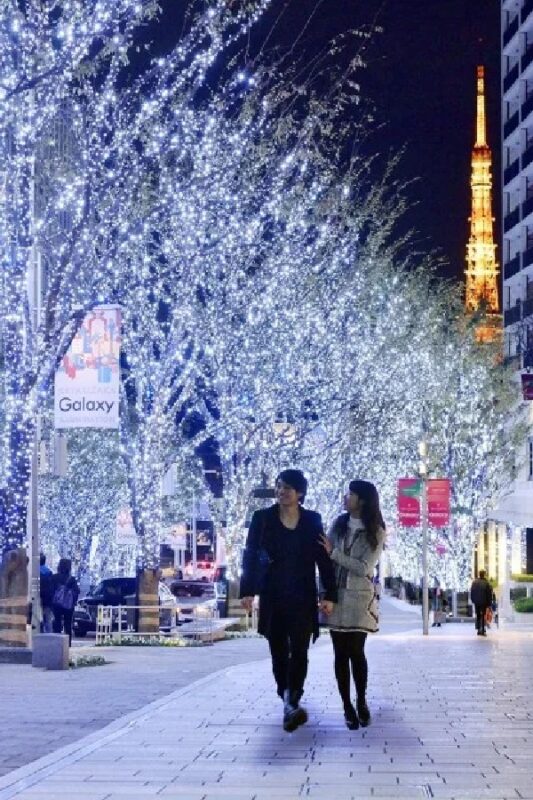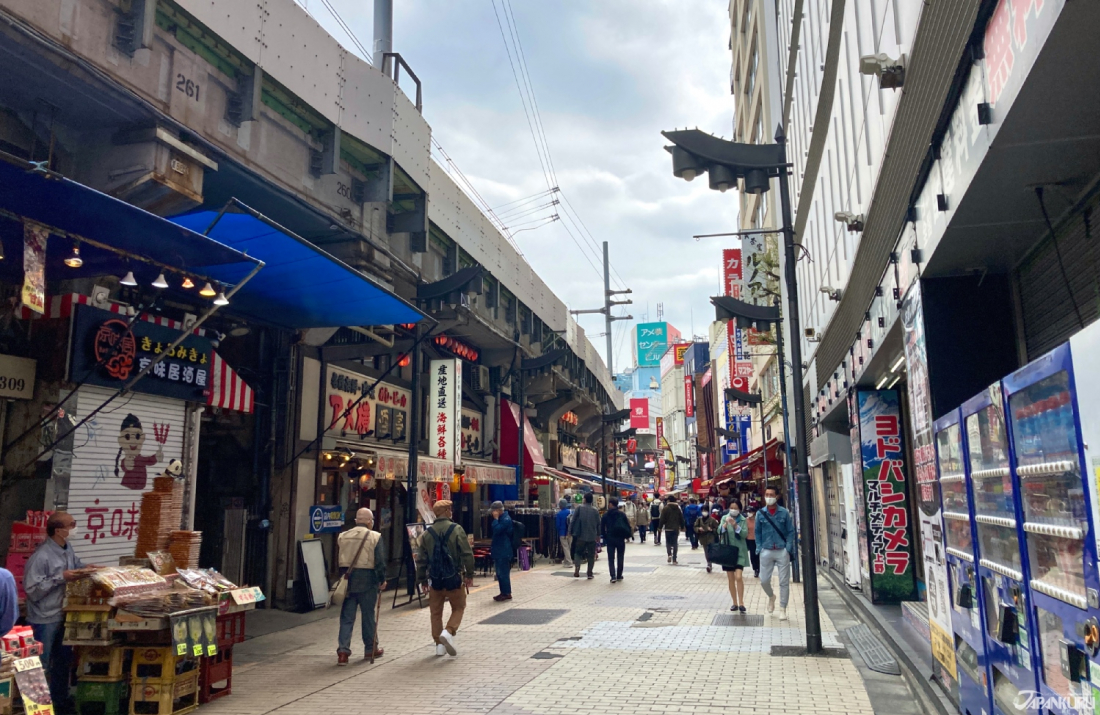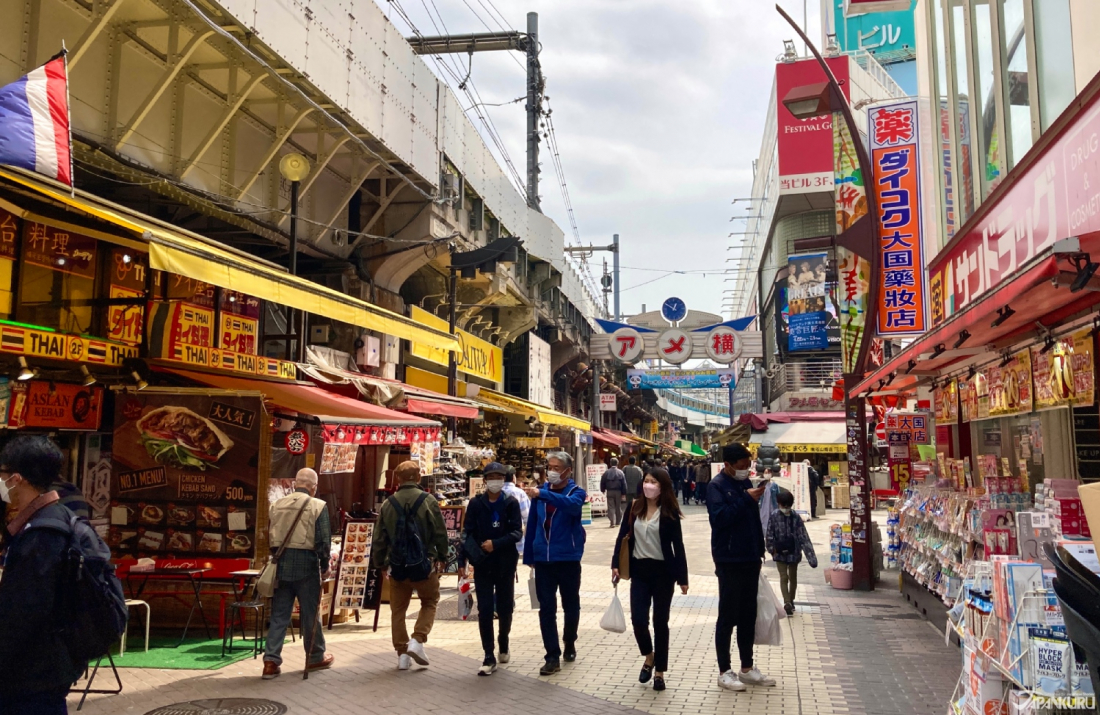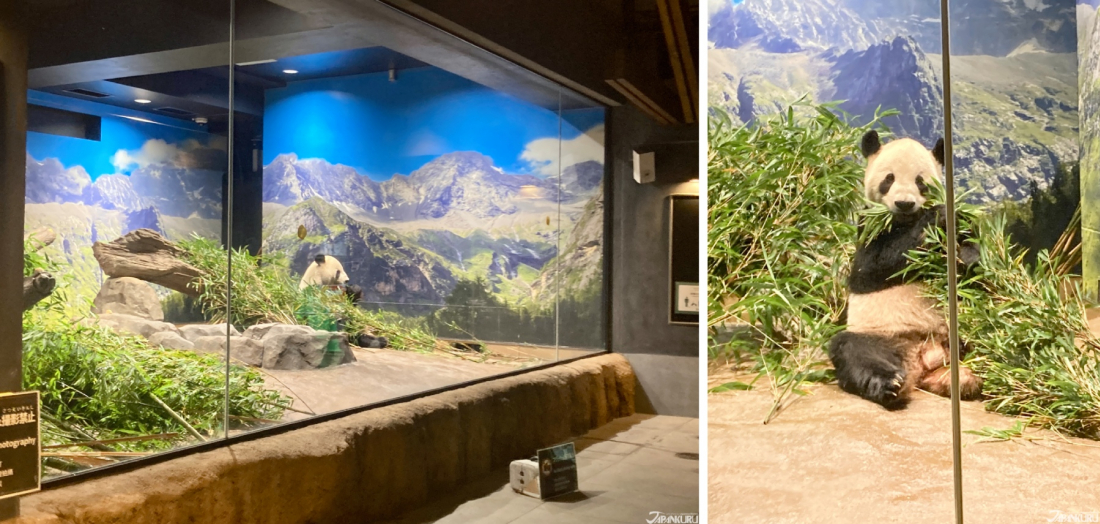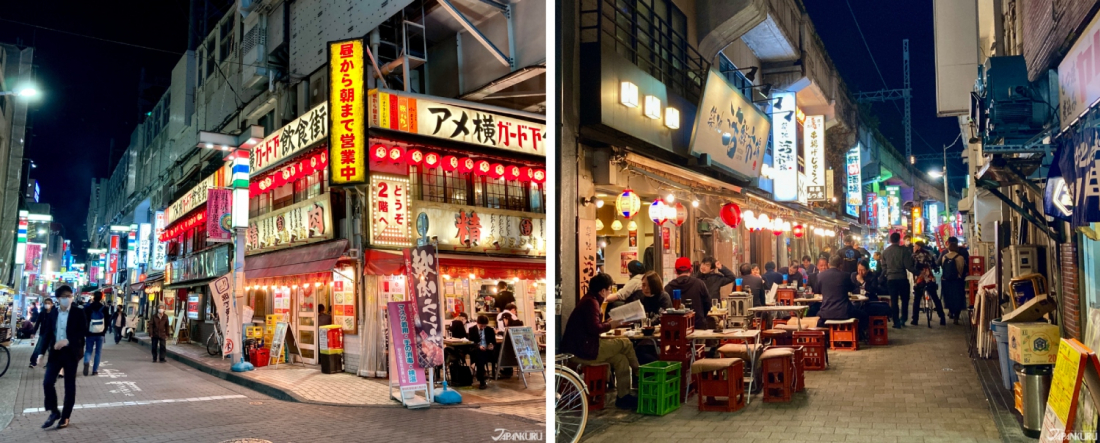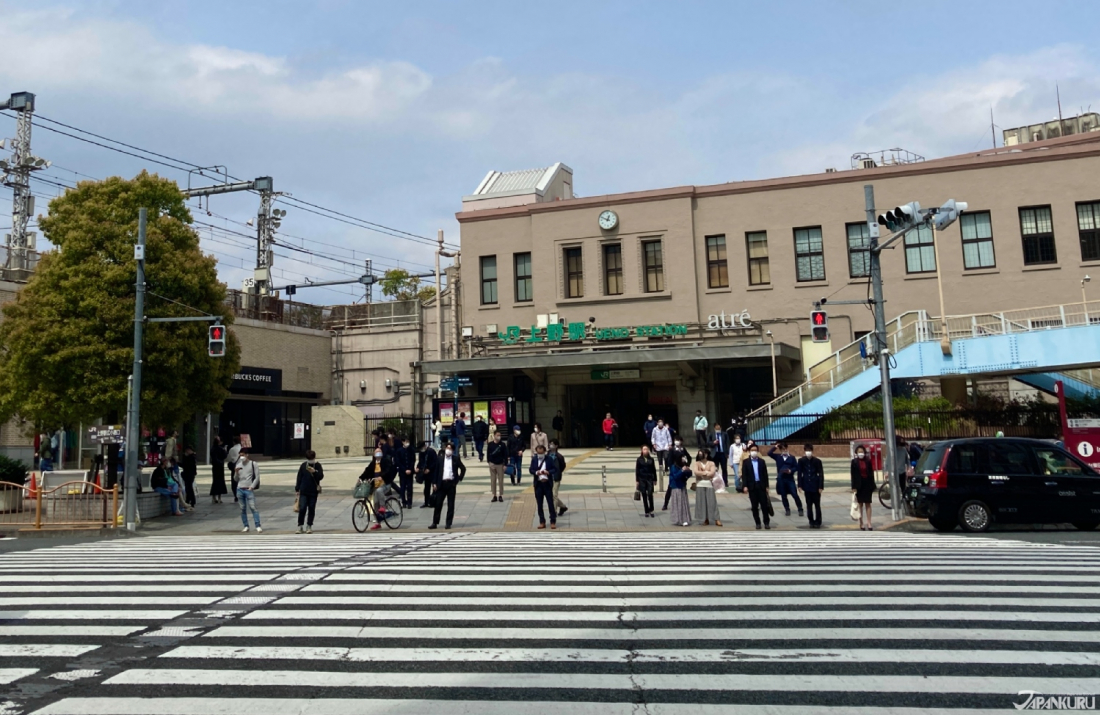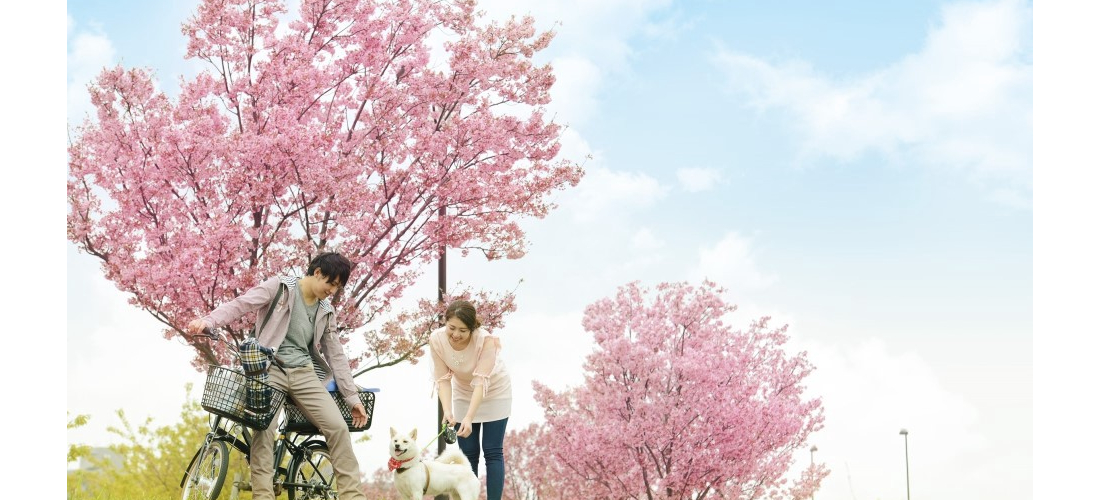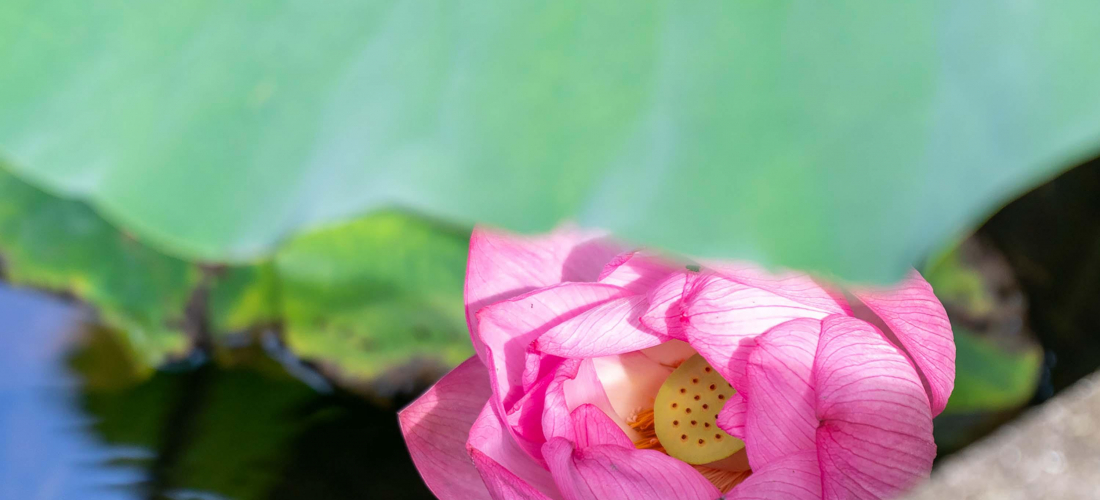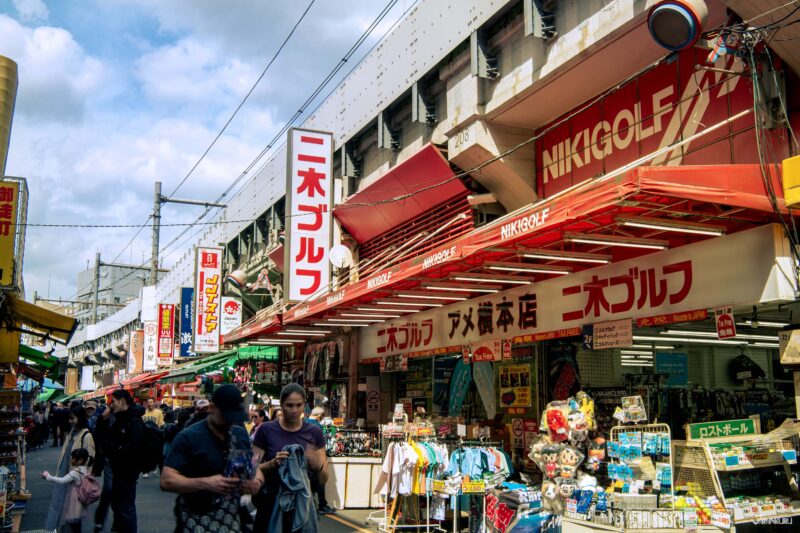CONTENTS
From pandas and broad park paths, to narrow alleys filled with local nightlife, this is Ueno!
A Quick Look at Ueno
Like so many parts of Japan, the Ueno neighborhood is a unique mix of new and old. Ueno Park was once the site of politically-driven samurai battles, but the area has always been part of Tokyo's lower-class "Shitamachi" area, encouraging the growth of lively markets and down-to-earth nightlife. Nowadays, travelers flock to the wide, flower-filled avenues of Ueno Park, not to mention its popular zoo and many museums, but the crowded alleys like Ameyoko are also filled with a diverse variety of shops, bars, and restaurants, making Ueno an ideal hangout spot for just about any kind of traveler!
① Browse the Wares Along Ameya Yokocho
For a glimpse of Ueno history, there's no better destination than the market street of Ameya Yokocho, or Ameyoko as the locals call it. Ameyoko is a crowded pedestrian street running along the train line from Ueno Station to Okachimachi Station, lined with shops selling cooked street food and fresh seafood, enormous bags of tea and huge sacks of dry goods, imported delicacies and traditional Japanese snacks, plus clothes, shoes, accessories, and just about anything else you might want. Ameyoko originally sprang up after the war, taking over the bombed ruins of a previous shopping and residential area, and the unique mix of Shitamachi residents built up their temporary stalls into the frenzied marketplace found today. It's only about a 10-minute walk from one end of Ameyoko to the other, but with all the delicious smells, unique goods, and crowds of pedestrians there to catch your attention, it's easy to spend hours wandering through the market.
Ameya Yokocho/Ameyoko (アメヤ横丁/アメ横)
10 Ueno, Taito City, Tokyo
Official Website (jp)
Want a little Ameyoko trivia before you go? The name Ameya Yokocho dates back to the market's early days, but there are actually two theories regarding the name's origins. Some say this Yokocho (alley) was named after the many shops that sold candy (ame/飴 in Japanese) in the postwar period, despite Japan's sugar shortages. Others think the street was named after the American army surplus stores that popped up around the same time!
② Relax in Ueno Park
Ready to finally venture into the famous Ueno Park? This large urban park sports broad paved paths, shady trees, and cool ponds full of lotus flowers and lilypads, all of which make it a popular oasis throughout the year. Joggers run past early in the morning, and the two cafes near the park's large fountain fill throughout the day with customers who come to sip their coffee in the fresh air. But Ueno Park is undoubtedly most popular during the spring, when the yearly cherry blossom festival draws enormous crowds to revel under the flowers. More than 800 cherry trees explode into bloom during late March and early April each year, and the tree-lined road running through the center of the park is one of Tokyo's must-see hanami spots. (Even during the COVID-19 pandemic, when cherry blossom viewing picnics have been temporarily banned, the park still sees a huge influx of people during cherry blossom season, enjoying the beauty of this open-air event.)
Ueno Park (上野恩賜公園)
Uenokoen, Taito City, Tokyo
Official Website (en)
③ Meet the Pandas at Ueno Zoo
Ueno Zoo is the oldest in Japan, and since its establishment in 1882, the zoo has grown to house over 3,000 animals from 400 different species. While the urban location (right inside Ueno Park and just steps from Ueno Station) has kept the zoo moderately compact, animal lovers young and old can appreciate the many different areas and animal exhibits found right in the middle of the city, from huge elephants to little Japanese macaques. Of course, the most popular residents of the zoo are more recent arrivals! The first giant pandas came to Ueno Zoo on loan from China back in 1972, and a series of furry friends have followed. The zoo's current breeding pair are Ri Ri and Shin Shin, who gave birth to daughter Xiang Xiang in 2017, and then to new twins (Xiao Xiao and Lei Lei) in 2021! There's nothing more relaxing than watching Ueno's content pandas climbing tree branches and munching on enormous piles of bamboo, and the charismatic black-and-white bears have become a symbol of Ueno. Plus, with fairly reasonable ticket prices (about 600 yen for adults and free for children), Ueno Zoo is a popular destination for families and anyone looking for a fun activity out in the fresh air.
Ueno Zoo (上野動物園)
9-83 Uenokoen, Taito City, Tokyo
Official Website (en)
④ Visit One of the Many Ueno Museums
No matter where your interest lies, Ueno is heaven for museum lovers, with half a dozen different institutions clustered around Ueno Park, each sporting its own permanent collections and temporary exhibitions. Just the Tokyo National Museum alone has five different buildings, each displaying different collections of art and antiquities from Japan and other parts of Asia, with frequent traveling exhibitions visiting the Heiseikan building. On the northwestern corner of Ueno Park, the Tokyo Metropolitan Art Museum is always changing up its collections, often displaying work from lesser-known Japanese artists, national art competitions, local caligraphers, or even the thesis work of nearby Tokyo University of the Arts students.
On the other side of the park's large fountain, three museums (plus the Bunka Kaikan concert hall) border the eastern side of the park. The National Museum of Nature and Science has dinosaur fossils, rooms dedicated to Japan's rarest species, and exhibitions on the evolution of both life and technology. After major renovations that closed the National Museum of Western Art for a year and a half, the museum is finally back to presenting the public with a collection of Western art mainly focused on art from the past couple centuries, featuring Renoir, Van Gogh, Picasso, and Monet. The Ueno Royal Museum was established to shine a light on new generations of artists, and it does often feature contemporary work, but it also provides space for a wide variety of unique traveling exhibitions.
For a different kind of museum experience, head to the southern tip of Ueno Park to check out the Shitamachi Museum, which is all about the history and culture of Tokyo's Shitamachi area, shining a light on the lives of normal people living in the city. Whether your tastes tend towards art, history, or science, there's a museum in Ueno for you!
⑤ Eat, Drink, and Be Merry Under the Train Tracks
After a full day enjoying the park, the zoo, the museums, and the market, Ueno is an ideal place for a cold drink and a bite to eat. The area is known for casual nightlife, and on top of the many shops and stalls along Ameyoko, there are quite a few restaurants, bars, and izakaya crowded into the criss-cross of alleys. Head under the train tracks for local favorites, serving yakitori and other hearty otsumami ("drinking snacks") to go with draft beer and whisky highballs, and flimsy seating spilling out the door onto the path out front. Or explore the side streets for quieter spots, family-friendly restaurants, and a couple of more high-brow bars serving fancy cocktails.
Around Ueno
Ueno's past has shaped it in unique ways, leaving a history-filled park studded with cherry blossoms, museums, and a famous zoo, just across the street from a bright postwar marketplace with lively bars and eateries. It's an easy spot to while the time away, but for anyone looking to see as much of Tokyo as they can in a limited amount of time, Ueno is also quite conveniently located. To the east, the Asakusa area and its famous Sensoji Temple are just a 5-minute subway ride (or 30-minute walk) away, and from Asakusa the towering Tokyo Skytree is easily accessible. To the west, the Yanesen area has become increasingly popular among young travelers in recent years thanks to a number of trendy new shops, restaurants, and cafes, alongside the enduring retro-cool of the Yanaka Ginza shopping street. Finally, just 3 minutes on the train or 20 minutes on foot heading south, you'll find Tokyo's center for arcades, anime goods, technology, and all things nerdy: Akihabara. With so much to see in the area, you might end up spending much more than a day in and around Ueno!
For more info and updates from Japan, check Japankuru for new articles, and don't forget to follow us on Twitter, Instagram, and Facebook!
Details
NAME:Ueno (上野)
COMMENT
FEATURED MEDIA
VIEW MORE 
A New Tokyo Animal Destination: Relax & Learn About the World’s Animals in Japan
#pr #japankuru #anitouch #anitouchtokyodome #capybara #capybaracafe #animalcafe #tokyotrip #japantrip #카피바라 #애니터치 #아이와가볼만한곳 #도쿄여행 #가족여행 #東京旅遊 #東京親子景點 #日本動物互動體驗 #水豚泡澡 #東京巨蛋城 #เที่ยวญี่ปุ่น2025 #ที่เที่ยวครอบครัว #สวนสัตว์ในร่ม #TokyoDomeCity #anitouchtokyodome

Shohei Ohtani Collab Developed Products & Other Japanese Drugstore Recommendations From Kowa
#pr #japankuru
#kowa #syncronkowa #japanshopping #preworkout #postworkout #tokyoshopping #japantrip #일본쇼핑 #일본이온음료 #오타니 #오타니쇼헤이 #코와 #興和 #日本必買 #日本旅遊 #運動補充能量 #運動飲品 #ช้อปปิ้งญี่ปุ่น #เครื่องดื่มออกกำลังกาย #นักกีฬา #ผลิตภัณฑ์ญี่ปุ่น #อาหารเสริมญี่ปุ่น

도쿄 근교 당일치기 여행 추천! 작은 에도라 불리는 ‘가와고에’
세이부 ‘가와고에 패스(디지털)’ 하나면 편리하게 이동 + 가성비까지 완벽하게! 필름카메라 감성 가득한 레트로 거리 길거리 먹방부터 귀여움 끝판왕 핫플&포토 스폿까지 총집합!
Looking for day trips from Tokyo? Try Kawagoe, AKA Little Edo!
Use the SEIBU KAWAGOE PASS (Digital) for easy, affordable transportation!
Check out the historic streets of Kawagoe for some great street food and plenty of picturesque retro photo ops.
#pr #japankuru #도쿄근교여행 #가와고에 #가와고에패스 #세이부패스 #기모노체험 #가와고에여행 #도쿄여행코스 #도쿄근교당일치기 #세이부가와고에패스
#tokyotrip #kawagoe #tokyodaytrip #seibukawagoepass #kimono #japantrip

Hirakata Park, Osaka: Enjoy the Classic Japanese Theme Park Experience!
#pr #japankuru #hirakatapark #amusementpark #japantrip #osakatrip #familytrip #rollercoaster #retrôvibes #枚方公園 #大阪旅遊 #關西私房景點 #日本親子旅行 #日本遊樂園 #木造雲霄飛車 #히라카타파크 #สวนสนุกฮิราคาตะพาร์ค

🍵Love Matcha? Upgrade Your Matcha Experience With Tsujiri!
・160년 전통 일본 말차 브랜드 츠지리에서 말차 덕후들이 픽한 인기템만 골라봤어요
・抹茶控的天堂!甜點、餅乾、飲品一次滿足,連伴手禮都幫你列好清單了
・ส่องมัทฉะสุดฮิต พร้อมพาเที่ยวร้านดังในอุจิ เกียวโต
#pr #japankuru #matcha #matchalover #uji #kyoto #japantrip #ujimatcha #matchalatte #matchasweets #tsujiri #말차 #말차덕후 #츠지리 #교토여행 #말차라떼 #辻利抹茶 #抹茶控 #日本抹茶 #宇治 #宇治抹茶 #日本伴手禮 #抹茶拿鐵 #抹茶甜點 #มัทฉะ #ของฝากญี่ปุ่น #ชาเขียวญี่ปุ่น #ซึจิริ #เกียวโต

・What Is Nenaito? And How Does This Sleep Care Supplement Work?
・你的睡眠保健品——認識「睡眠茶氨酸錠」
・수면 케어 서플리먼트 ‘네나이토’란?
・ผลิตภัณฑ์เสริมอาหารดูแลการนอน “Nenaito(ネナイト)” คืออะไร?
#pr #japankuru #sleepcare #japanshopping #nenaito #sleepsupplement #asahi #睡眠茶氨酸錠 #睡眠保健 #朝日 #l茶胺酸 #日本藥妝 #日本必買 #일본쇼핑 #수면 #건강하자 #네나이토 #일본영양제 #อาหารเสริมญี่ปุ่น #ช้อปปิ้งญี่ปุ่น #ร้านขายยาญี่ปุ่น #ดูแลตัวเองก่อนนอน #อาซาฮิ

Japanese Drugstore Must-Buys! Essential Items from Hisamitsu® Pharmaceutical
#PR #japankuru #hisamitsu #salonpas #feitas #hisamitsupharmaceutical #japanshopping #tokyoshopping #traveltips #japanhaul #japantrip #japantravel

Whether you grew up with Dragon Ball or you just fell in love with Dragon Ball DAIMA, you'll like the newest JINS collab. Shop this limited-edition Dragon Ball accessory collection to find some of the best Dragon Ball merchandise in Japan!
>> Find out more at Japankuru.com! (link in bio)
#japankuru #dragonball #dragonballdaima #animecollab #japanshopping #jins #japaneseglasses #japantravel #animemerch #pr

This month, Japankuru teamed up with @official_korekoko to invite three influencers (originally from Thailand, China, and Taiwan) on a trip to Yokohama. Check out the article (in Chinese) on Japankuru.com for all of their travel tips and photography hints - and look forward to more cool collaborations coming soon!
【橫濱夜散策 x 教你怎麼拍出網美照 📸✨】
每次來日本玩,是不是都會先找旅日網紅的推薦清單?
這次,我們邀請擁有日本豐富旅遊經驗的🇹🇭泰國、🇨🇳中國、🇹🇼台灣網紅,帶你走進夜晚的橫濱!從玩樂路線到拍照技巧,教你怎麼拍出最美的夜景照。那些熟悉的景點,換個視角說不定會有新發現~快跟他們一起出發吧!
#japankuru #橫濱紅磚倉庫 #汽車道 #中華街 #yokohama #japankuru #橫濱紅磚倉庫 #汽車道 #中華街 #yokohama #yokohamaredbrickwarehouse #yokohamachinatown

If you’re a fan of Vivienne Westwood's Japanese designs, and you’re looking forward to shopping in Harajuku this summer, we’ve got important news for you. Vivienne Westwood RED LABEL Laforet Harajuku is now closed for renovations - but the grand reopening is scheduled for July!
>> Find out more at Japankuru.com! (link in bio)
#japankuru #viviennewestwood #harajuku #omotesando #viviennewestwoodredlabel #viviennewestwoodjapan #비비안웨스트우드 #오모테산도 #하라주쿠 #日本購物 #薇薇安魏斯伍德 #日本時尚 #原宿 #表參道 #japantrip #japanshopping #pr

Ready to see TeamLab in Kyoto!? At TeamLab Biovortex Kyoto, the collective is taking their acclaimed immersive art and bringing it to Japan's ancient capital. We can't wait to see it for ourselves this autumn!
>> Find out more at Japankuru.com! (link in bio)
#japankuru #teamlab #teamlabbiovortex #kyoto #kyototrip #japantravel #artnews
Photos courtesy of teamLab, Exhibition view of teamLab Biovortex Kyoto, 2025, Kyoto ® teamLab, courtesy Pace Gallery

Japanese Makeup Shopping • A Trip to Kamakura & Enoshima With Canmake’s Cool-Toned Summer Makeup
#pr #canmake #enoshima #enoden #에노시마 #캔메이크 #japanesemakeup #japanesecosmetics

⚔️The Robot Restaurant is gone, but the Samurai Restaurant is here to take its place. Check it out, and don't forget your coupon!
🍣신주쿠의 명소 로봇 레스토랑이 사무라이 레스토랑으로 부활! 절찬 쿠폰 발급중
💃18歲以上才能入場的歌舞秀,和你想的不一樣!拿好優惠券去看看~
#tokyo #shinjuku #samurairestaurant #robotrestaurant #tokyotrip #도쿄여행 #신주쿠 #사무라이레스토랑 #이색체험 #할인이벤트 #歌舞伎町 #東京景點 #武士餐廳 #日本表演 #日本文化體驗 #japankuru #japantrip #japantravel #japanlovers #japan_of_insta

Japanese appliance & electronics shopping with our KOJIMA x BicCamera coupon!
用JAPANKURU的KOJIMA x BicCamera優惠券買這些正好❤️
코지마 x 빅 카메라 쿠폰으로 일본 가전 제품 쇼핑하기
#pr #japankuru #japanshopping #kojima #biccamera #japaneseskincare #yaman #dji #osmopocket3 #skincaredevice #日本購物 #美容儀 #相機 #雅萌 #日本家電 #일본여행 #면세 #여행꿀팁 #일본쇼핑리스트 #쿠폰 #일본쇼핑 #일본브랜드 #할인 #코지마 #빅카메라 #japankurucoupon
MAP OF JAPAN
SEARCH BY REGION

LATEST
VIEW MOREEVENT CALENDAR
VIEW MORE
